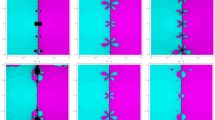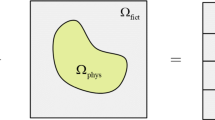Abstract
In this article, a simple way to determine algorithmic parameters included in time approximations of two-stage implicit time schemes is presented. To be specific, algorithmic parameters of time approximations are mathematically determined to give higher-order total energy convergence rates for conservative nonlinear problems while satisfying traditional linear accuracy requirements. Due to the use of newly proposed algorithmic parameters, two-stage implicit time schemes can possess enhanced total energy conserving capabilities for conservative nonlinear problems while providing improved linear performances when compared with those of the existing two-stage time schemes. Enhanced total energy conserving capabilities achieved through the use of newly proposed algorithmic parameters do not require any additional computational efforts when compared with the existing two-stage schemes. This article also explains that a certain standard type of two-stage implicit time schemes can reduce computational time and effort in linear analyses if effective coefficient matrices of the first and second stages are constructed identically. For the verification of improved numerical performances, linear and nonlinear benchmark problems are solved, and their numerical results are investigated to support the main discussions of this article.
































Similar content being viewed by others
Data Availability
The data that supports the findings of this study is available from the corresponding author [Wooram Kim], upon reasonable request.
References
Li, Y.A., Olver, P.J., Rosenau P.: Non-analytic solutions of nonlinear wave models. nonlinear theory of generalized functions (vienna, 1997), pp. 129–145 (1999)
Wulff, C., Evans, C.: Runge-kutta time semidiscretizations of semilinear pdes with non-smooth data. Numer. Math. 134, 413–440 (2016)
Kim, W.: An improved implicit method with dissipation control capability: the simple generalized composite time integration algorithm. Appl. Math. Model. 81, 910–930 (2020)
Butcher, J.C.: A stability property of implicit Runge-Kutta methods. BIT Numer. Math. 15(4), 358–361 (1975)
Ji, Y., Xing, Y., Wiercigroch, M.: An unconditionally stable time integration method with controllable dissipation for second-order nonlinear dynamics. Nonlinear Dyn. 105(4), 3341–3358 (2021)
Li, J., Yu, K.: A simple truly self-starting and l-stable integration algorithm for structural dynamics. Int. J. Appl. Mech. 12(10), 2050119 (2020)
Kim, W., Reddy, J.N.: A comparative study of implicit and explicit composite time integration schemes. Int. J. Struct. Stab. Dyn. 20(13), 2041003 (2020)
Hilber, H.M., Hughes, T.J.R., Taylor, R.L.: Improved numerical dissipation for time integration algorithms in structural dynamics. Earthq. Eng. Struct. Dyn. 5(3), 283–292 (1977)
Chung, J., Hulbert, G.M.: A time integration algorithm for structural dynamics with improved numerical dissipation: the generalized-alpha method. J. Appl. Mech. 60, 271–275 (1993)
Baig, M.M.I., Bathe, K.J.: On direct time integration in large deformation dynamic analysis. In: 3rd MIT Conference on Computational Fluid and Solid Mechanics, pp. 1044–1047 (2005)
Kim, W., Choi, S.Y.: An improved implicit time integration algorithm: the generalized composite time integration algorithm. Comput. Struct. 196, 341–354 (2018)
Kim, W., Reddy, J.N.: Novel explicit time integration schemes for efficient transient analyses of structural problems. Int. J. Mech. Sci. 172, 105429 (2020)
Hughes, T.J.R.: Analysis of transient algorithms with particular reference to stability behavior. Computational methods for transient analysis( A 84-29160 12-64). Amsterdam, North-Holland, 1983, pp. 67–155 (1983)
Fung, T.C.: Unconditionally stable higher-order accurate Hermitian time finite elements. Int. J. Numer. Meth. Eng. 39(20), 3475–3495 (1996)
Kim, W., Reddy, J.N.: An improved time integration algorithm: a collocation time finite element approach. Int. J. Struct. Stab. Dyn. 17(2), 1750024 (2017)
Noh, G., Bathe, K.J.: The Bathe time integration method with controllable spectral radius: the \({\rho }_{\infty }\)-Bathe method. Comput. Struct. 212, 299–310 (2019)
Reddy, J.N.: An introduction to the finite element method, vol. 1221. McGraw-Hill, New York (2004)
Kim, W., Reddy, J.N.: A novel family of two-stage implicit time integration schemes for structural dynamics. Int. J. Comput. Methods 18(08), 2150021 (2021)
Bathe, K.J.: Finite Element Procedures. Klaus-Jurgen Bathe, Berlin (2006)
Bathe, K.J., Wilson, E.L.: Stability and accuracy analysis of direct integration methods. Earthq. Eng. Struct. Dyn. 1(3), 283–291 (1972)
Liu, W., Ye, T., Yuan, P., Beer, M., Tong, X.: An explicit integration method with third-order accuracy for linear and nonlinear dynamic systems. Eng. Struct. 274, 115013 (2023)
Kuo, S., Yau, J.D., Yang, Y.B.: A robust time-integration algorithm for solving nonlinear dynamic problems with large rotations and displacements. Int. J. Struct. Stab. Dyn. 12(6), 1250051 (2012)
Depouhon, A., Detournay, E., Denoël, V.: Accuracy of one-step integration schemes for damped/forced linear structural dynamics. Int. J. Numer. Meth. Eng. 99(5), 333–353 (2014)
Kim, W., Reddy, J.N.: A critical assessment of two-stage composite time integration schemes with a unified set of time approximations. Latin Amer. J. Solids Struct. 18, e367 (2021)
Tarnow, N., Simo, J.C.: How to render second order accurate time-stepping algorithms fourth order accurate while retaining the stability and conservation properties. Comput. Methods Appl. Mech. Eng. 115(3–4), 233–252 (1994)
Qin, M., Zhang, M.: Symplectic Runge-Kutta algorithms for Hamiltonian systems. J. Comput. Math. 10, 205–215 (1992)
Kraaijevanger, J.F.B.M., Spijker, M.N.: Algebraic stability and error propagation in Runge-Kutta methods. Appl. Numer. Math. 5(1–2), 71–87 (1989)
Kim, W.: An accurate two-stage explicit time integration scheme for structural dynamics and various dynamic problems. Int. J. Numer. Meth. Eng. 120(1), 1–28 (2019)
Xie, Y.M.: An assessment of time integration schemes for non-linear dynamic equations. J. Sound Vib. 192(1), 321–331 (1996)
Kim, W., Choi, H.G., Kwon, S.: Higher-order accurate explicit time schemes with improved dissipation properties. Int. J. Struct. Stab. Dyn. 4, 2350166 (2023)
Reddy, J.N.: An Introduction to Nonlinear Finite Element Analysis Second Edition: with applications to heat transfer, fluid mechanics, and solid mechanics. Oxford (2014)
Bathe, K.J., Noh, G.: Insight into an implicit time integration scheme for structural dynamics. Comput. Struct. 98, 1–6 (2012)
Piché, R.: An l-stable Rosenbrock method for step-by-step time integration in structural dynamics. Comput. Methods Appl. Mech. Eng. 126(3–4), 343–354 (1995)
Malakiyeh, M.M., Shojaee, S., Bathe, K.J.: The Bathe time integration method revisited for prescribing desired numerical dissipation. Comput. Struct. 212, 289–298 (2019)
Noh, G., Ham, S., Bathe, K.J.: Performance of an implicit time integration scheme in the analysis of wave propagations. Comput. Struct. 123, 93–105 (2013)
De Hoop, A.T.: A modification of Cagniard’s method for solving seismic pulse problems. Appl. Sci. Res. Sect. B 8(1), 349–356 (1960)
Lamb, H.: On the propagation of tremors over the surface of an elastic solid. Proc. R. Soc. Lond. 72, 128–130 (1903)
Kim, K., Bathe, K.J.: Accurate solution of wave propagation problems in elasticity. Comput. Struct. 249, 106502 (2021)
Acknowledgements
The author deeply appreciates supports from Ra-Kyoung Yoon, Dal-Soo Yoon, and Seung-Im Paek.
Funding
This research received no specific grant from any funding agency in the public, commercial, or not-for-profit sectors.
Author information
Authors and Affiliations
Corresponding author
Ethics declarations
Conflicts of interest
The authors whose names are listed immediately below certify that they have NO affiliations with or involvement in any organization or entity with any financial interest (such as honoraria; educational grants; participation in speakers’ bureaus; membership, employment, consultancies, stock ownership, or other equity interest; and expert testimony or patent-licensing arrangements), or non-financial interest (such as personal or professional relationships, affiliations, knowledge, or beliefs) in the subject matter or materials discussed in this manuscript.
Additional information
Publisher's Note
Springer Nature remains neutral with regard to jurisdictional claims in published maps and institutional affiliations.
Rights and permissions
Springer Nature or its licensor (e.g. a society or other partner) holds exclusive rights to this article under a publishing agreement with the author(s) or other rightsholder(s); author self-archiving of the accepted manuscript version of this article is solely governed by the terms of such publishing agreement and applicable law.
About this article
Cite this article
Kim, W. Improved two-stage implicit time integration methods with unconventionally determined parameters for analyses of linear and nonlinear structural dynamics. Nonlinear Dyn 112, 1221–1259 (2024). https://doi.org/10.1007/s11071-023-09101-6
Received:
Accepted:
Published:
Issue Date:
DOI: https://doi.org/10.1007/s11071-023-09101-6




